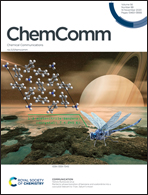Co-immobilization of metal and enzyme into hydrophobic nanopores for highly improved chemoenzymatic asymmetric synthesis†
Abstract
Chemoenzymatic catalysts with hydrophobic nanopores were fabricated by co-immobilizing metal nanoparticles and enzymes into the dendritic organosilica nanoparticles. They demonstrated highly improved catalytic performance in chemoenzymatic asymmetric synthesis of chiral amines and alcohols. The hydrophobic microenvironment proved to be critical to enhanced stability, activity and cascade efficiency.



 Please wait while we load your content...
Please wait while we load your content...